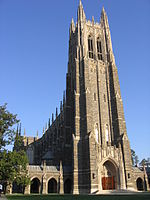- Duke University Hospital
-
Duke University Hospital Duke University Health System 
Geography Location Durham, North Carolina, USA Organisation Hospital type Teaching Affiliated university Duke University Services Emergency department Level I Beds 924 licensed beds History Founded 1925 as a gift from James B. Duke. Hospital did not accept patients until 1930. Links Website www.dukehealth.org Lists Duke University Medical Center (commonly referred to as Duke University Hospital) is a 924-bed academic tertiary care facility located in Durham, North Carolina. Since its establishment in 1930, the hospital has grown from a small regional hospital to an academic medical center. Duke University Hospital is the flagship teaching hospital for the Duke University Health System, a network of physicians and hospitals serving Durham County and Wake County, North Carolina, and surrounding areas, as well as one of three Level I referral centers for the Research Triangle of North Carolina (the other two are UNC Hospitals in nearby Chapel Hill and WakeMed Raleigh in Raleigh).
Contents
History
1924–1935: early years
The institution can trace its roots back to 1924, six years before the opening of the hospital, when James Buchanan Duke established the Duke Endowment to transform Duke University (then known as Trinity College) into the research university it is today. In 1925, Duke bequeathed $4 million to establish the medical school, nursing school, and hospital.[1] Two years later, in 1927, construction began on the original hospital (now known as Duke South), which opened on July 21, 1930, with 400 beds. In 1931, the hospital and medical school were officially dedicated on April 20 and the Private Diagnostic Clinic (Duke's in-house physician system) was organized on September 16.[2] In 1935, less than five years after the hospital opened, the American Medical Association ranked Duke among the top 20 of medical schools in the country.[1]
1936–1969: a number of firsts
In 1936, a team of physicians led by Dr. Julian Deryl Hart introduced ultraviolet light to kill germs in the operating room as a way to combat post-operative staph infections, greatly reducing the number of infections and related deaths.[3] In the same year, the hospital established the nation's first brain tumor program, launching what would become one of the world's most renowned programs in the field of cancer treatment. In 1937, Joseph Beard developed a vaccine against equine encephalomyelitis, one of the first known vaccines to combat the mosquito-carried disease.[4]
In 1940, the hospital made its first expansion, adding a new wing to the original building. In 1947, the Bell Research Building became the first freestanding building on the hospital campus. In 1954, the Duke Poison Control Center was organized, becoming one of the first two organized in the country.
In 1955, psychiatrist Ewald W. Busse established the Duke University Center for Aging, the first research center of its kind in the nation.[5] Currently the oldest continuously operating facility in the United States, this center has pioneered long-term studies of health problems among seniors.
In 1956, Duke surgeons performed the first cardiac surgery using systemic hypothermia to bring a patient's body temperature down to less than 50 degrees Fahrenheit in an effort to minimize tissue damage during lengthy surgeries. With the success of this experiment, systemic hypothermia has become standard procedure in all hospitals worldwide. In 1957, the hospital and medical school were renamed Duke University Medical Center. In 1958, Thelma Ingles, a professor and chair of the Department of Medical-Surgical Nursing, developed the clinical nursing specialist program, becoming the first master's program of its kind in the United States. The establishment of the nursing specialist program paved the way for advanced clinical knowledge in the delivery and teaching of the nursing field.
The 1960s brought extraordinary firsts to Duke. In 1963, the first African-American student was accepted to the prestigious medical school. Two years later, in 1965, the hospital established the first physician assistant program in the country. In 1966, Duke became the first medical center in the world to offer radio consultation with physicians in developing countries. This program, called Med-Aid (short for Medical Assistance for Isolated Doctors), met the critical needs of the physicians who lacked proper treatment.[clarification needed] That same year, the Medical Scientist Training Program, a joint program leading to simultaneous M.D. and Ph.D degrees, was established, becoming one of the first three in the nation. In 1969, the first recorded studies of human's abilities to function and work at pressures equal to a 1,000-foot (300 m) deep sea dive were conducted in the hyperbaric chamber.[6]
1970–1989: a period of growth and expansion
With the dawn of the 1970s, Duke underwent a period of expansion that continued well into the 1980s. In December 1971, the Duke Comprehensive Cancer Center was established under the National Cancer Act. Duke's cancer center, one of the first in the nation under this groundbreaking legislation, was officially designated as a "comprehensive" cancer center by the National Cancer Institute in 1973. That same year, the Duke Eye Center was dedicated and opened on November 8. In 1978, the Morris Cancer Research Building opened, giving researchers a place to study and find cures for the disease.
In 1980, Duke moved into its present $94.5 million facility (Duke North) on Erwin Road, located just north of its original location. In 1985, with the emergence of AIDS bringing alarm to the medical community, Duke became one of the first two hospitals to conduct human clinical trials on AZT, the first drug to offer an improved quality of life in patients battling AIDS.
1990–present: accelerated growth, expansion, and a glance towards the future
In the 1990s, the medical research at Duke reached the forefront for detection of ailments that can be treated with a larger success rate. In 1990, Duke geneticists invented a three-minute test to screen newborns for over 30 metabolic diseases at one time. This practice has since become standard worldwide.
In 1992, Duke's cancer center became the first hospital to develop an outpatient bone marrow transplant program. That same year, the hospital performed its first lung and heart/lung transplants.
The year 1994 marked the beginning of accelerated expansion for Duke. That year, the Levine Science Research Center and the Medical Sciences Research Center were opened. In addition, there were extensive renovations of the Duke Clinic (Duke South), additions to the Morris Cancer Research Building, a new Children's Health Center, a freestanding Ambulatory Care Center, and expanded parking options for visitors.
In 1998, the Duke University Health System was created with newly established partnerships with Durham Regional Hospital and Raleigh Community Hospital. That same year, the National Institutes of Health partnered with Duke to offer the first joint master's of health science in clinical research degree. With this extraordinary partnership, the NIH became the first organization to offer a joint graduate degree program with a major university.
In 2001, the hospital was the first to establish a center dedicated exclusively to Cardiovascular Magnetic Resonance Imaging.
Today, Duke University Hospital is still seeking life-changing breakthroughs to improve the quality of life for everyone in the world. In addition, the hospital is undergoing a major expansion project that will increase the size of its surgical ward and add two additional helipads to the hospital.
References
- ^ a b "Duke University Medical Center History". Duke Medical Center Library & Archives. http://archives.mc.duke.edu/history/history.html. Retrieved 2011-03-17.
- ^ "Dedication of Duke University School of Medicine and Duke Hospital, Durham, North Carolina, April 20, 1931". Southern Medical Journal, Journal of the Southern Medical Association 24 (12): 1099–1124. 1931=12. http://archives.mc.duke.edu/sites/default/files/publications/1931_smj_dedication_master.pdf. Retrieved 2011-03-17.
- ^ "Medicine: Germicidal Light". Time Magazine. 1936-06-15. http://www.time.com/time/magazine/article/0,9171,756311,00.html. Retrieved 2011-03-17.
- ^ Beard JW, Finkelstein H, Sealy WC, Wyckoff RW (May 1938). "IMMUNIZATION AGAINST EQUINE ENCEPHALOMYELITIS WITH CHICK EMBRYO VACCINES". Science (New York, N.Y.) 87 (2265): 490. doi:10.1126/science.87.2265.490. PMID 17772711. http://www.sciencemag.org/cgi/pmidlookup?view=long&pmid=17772711. Retrieved 2011-03-17.
- ^ Maddox, George L. Center for the Study of Aging and Human Development: History of the center.. http://www.geri.duke.edu/images/media/history/center-history.pdf. Retrieved 2011-03-17.
- ^ Camporesi, Enrico M (2007). "The Atlantis Series and Other Deep Dives.". In: Moon RE, Piantadosi CA, Camporesi EM (eds.). Dr. Peter Bennett Symposium Proceedings. Held May 1, 2004. Durham, N.C.: (Divers Alert Network). http://archive.rubicon-foundation.org/9057. Retrieved 2011-03-17.
External links
North Carolina Trauma Centers List of hospitals in North Carolina Level I *Carolinas Medical Center • *Duke University Hospital • *Pitt County Memorial Hospital • *UNC Hospitals • *Wake Forest Baptist Medical Center • WakeMedLevel II Mission Health System • *Moses Cone Health System • New Hanover Regional Medical CenterLevel III Carolinas Medical Center-NorthEast • Cleveland Regional Medical Center • High Point Regional Health SystemPediatric Level I - - Verified by the American College of Surgeons
North Carolina Designated Trauma Centers
Categories:- Duke University
- Hospitals in Durham, North Carolina
- University hospitals in the United States
Wikimedia Foundation. 2010.

